

Table of contents
- Who is harmful?
- Occurrence of the rose pests
- cutting tool and disposal
- Deformations, leaf damage, galls
- Leafcutter Bees (Megachile)
- Common rose gall wasp (Diplolepis rosae)
- Common rose chafer (Cetonia aurata)
- Gold macaw (Euproctis chrysorrhoea)
- Lesser rose chafer (Phyllopertha horticola)
- Rose leaf gall midge (Wachtliella rosarum)
- Rose leaf scroll wasp (Blennocampa phyllocolpa or Blennocampa pusilla)
- Rose blossom weevil (Mecorhis ungarica)
- Rose brush wasp (Arge rosae; argue ochropus)
- Rose flea beetle (Luperomorpha xanthodera)
- Arrow owl (Acronica psi; Arconycta psi; Apatele psi)
- Black sawfly (Endelomyia aethiops; Caliora aethiops)
- leaf miner
- Downward Rose Shoot Borer (Ardis brunniventis)
- Upward-climbing rose shoot borer (Blennocampa elongatula)
- Rose leaf miner (Coptotriche angusticollella; Emmetia angusticollella, Tischeria angusticollella)
- Rose jewel beetle (Agrilus cuprescens)
Rose pests have the property that they are often difficult to recognize, because only a few of the voracious pests are of an impressive size. In addition, they differ only slightly in appearance. Therefore, recognizing the damage pattern often leads to the goal more easily. Because not every pest immediately leads to total failure or has to be fought with full force.
Who is harmful?
Rose pests are mostly flying insects. However, it should be noted that the adult insects, whether beetles or moths, are often not the actual pests, but rather their offspring, because the plants serve them as nutrition in the nursery. However, danger lurks on two sides. On the one hand by the offspring, which will be sexually mature in the following year at the latest, and by the adult insects that have chosen the plants as hosts for the offspring. Therefore, it is advisable to pay attention to both generations, to take preventive measures so that egg laying does not occur in the first place. Natural predators usually help best with this form of defence, as they ensure a natural balance in the garden.
Occurrence of the rose pests
The distribution of the various pests varies. Some appear nationwide, some only regionally. Overall, however, it can be stated that the pests are spreading geographically, not least due to the rising temperatures. According to the calendar, rose pests can be expected from spring. Since some of the rose pests also develop two or more generations per year, the danger can extend into autumn (September, October). You should therefore regularly check the roses for pest infestation until autumn, especially if this is not the first infestation.
cutting tool and disposal
With many rose pests, it is often sufficient if they are removed mechanically or if the affected parts of the plant are cut off. However, you should not dispose of them in the compost, because some offspring continue to develop splendidly there. It is better if you dispose of the waste in the household waste. In order to rule out the risk of transmission as far as possible, you should always ensure that the cutting tool is clean. It is therefore advisable to clean it, even between cutting, even if it seems tedious at first glance.
Deformations, leaf damage, galls
This group includes pests that you can identify by the external appearance of roses. In this way, the rose petals are eaten or the buds are damaged. Galls are often referred to as nodules because they grow in place of buds or on leaves or stems. sit shoots They serve as nurseries for some insects, i.e. the offspring are located inside the galls in more or fewer chambers.
Leafcutter Bees (Megachile)
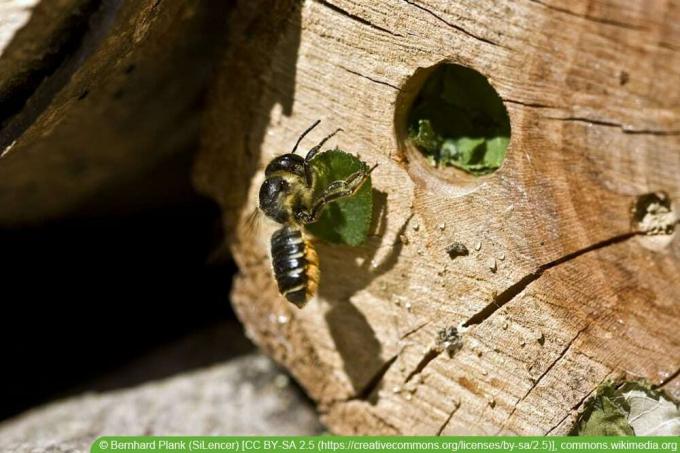
Damage:
- Circular to oval feeding marks on the leaf edges
- local leaf loss
- Material cut off is used by the bees to create nesting sites
- Breeding places not at the rose (possible up to a distance of 100 meters)
- Nourishing the offspring from the rose
Measures:
- Damage rather small
- No action necessary
A notice: If you do not take action here, you will help these wild bees, which look similar to the normal honey bee, but do not form colonies.
Common rose gall wasp (Diplolepis rosae)
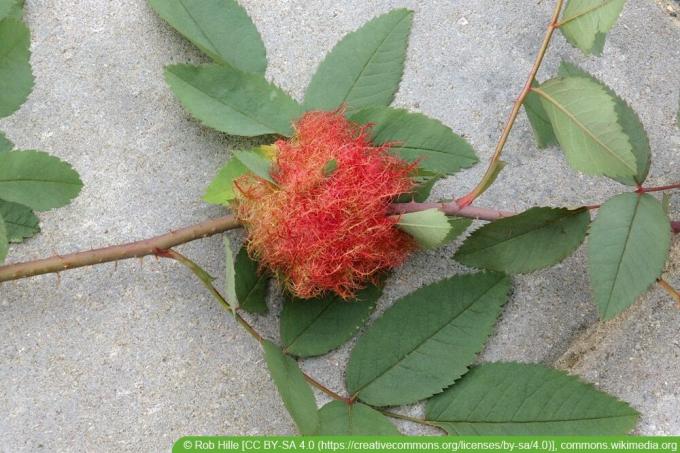
The common rose gall wasp belongs to the gall wasp family (Cynipidae).
Damage:
- Gallen, also called rose apple, bedeguare or sleeping apple
- spherical swellings instead of rosebuds at the middle or upper end of the shoot
- five to ten centimeters in diameter
- many colored mossy to hairy outgrowths (greenish, yellowish reddish)
- Rose gall chambers are used for larval development
Measure:
- remove with one cut
Common rose chafer (Cetonia aurata)

Synonyms: Rose Beetle, Golden Shiny Rose Beetle
Damage:
- flower feeding
A notice: This beetle species is protected in Germany. However, it doesn't do much damage either.
Gold macaw (Euproctis chrysorrhoea)
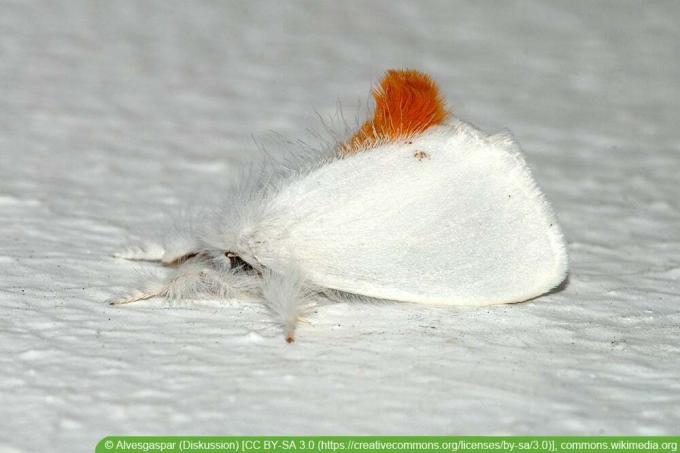
Damage:
- Eggs are laid on the underside of the leaves
- around 250 pieces per clutch
- elongated scrim: 2 x 0.5 centimeters
- covered with golden yellow after-wool
- Rather inconspicuous
- found in the outer, upper crown area
- Caterpillars hatch after two weeks
- scraping damage on the upper side of the leaf
- give off threads
- together with other leaves: fist-sized nest
- after hibernation: feeding on buds, then leaves (defoliation)
- Pupation in June on leaf or stem
A notice:
The hair of the eggs and caterpillars cause skin reactions in humans.
Measures:
- remove the webs in winter
Lesser rose chafer (Phyllopertha horticola)
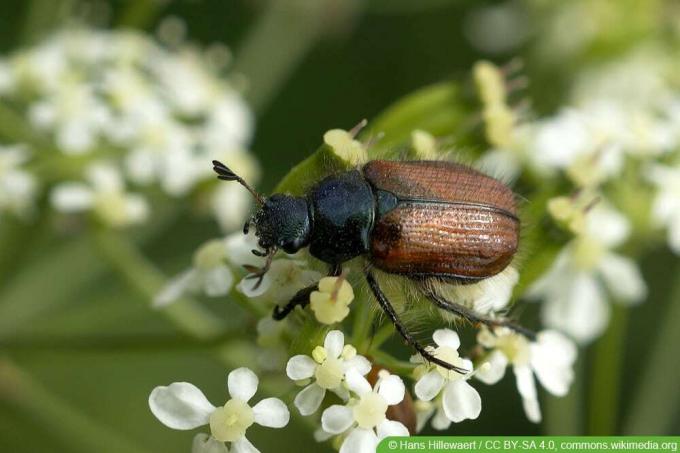
Synonyms: Garden chafer, June beetle
Damage:
- Eating marks on leaves and rose petals
- late May to late June
Measures:
- collect bugs
Rose leaf gall midge (Wachtliella rosarum)
Damage:
- Leaflets of the rose folded along the midrib
- Galls initially greenish, later reddish-brownish
- on upper shoots or to find leaf layers
- inside: legless larvae of the rose leaf gall midge
- Oviposition in late spring on the central axis of the leaves
Measures:
- collecting the leaves
Rose leaf scroll wasp (Blennocampa phyllocolpa or Blennocampa pusilla)
leaf scroll wasps (Blennocampinae) belong to the sawfly family (Tenthredinidae). They are often associated with the roller wasps (Tiphiidae) confused by name, but there is no relationship between the Hymenoptera. Within the real sawflies there are different subfamilies, such as the leaf scroll wasps (Blennocampinae).
Damage:
- curled leaves
- by the laying of eggs by the female rosette scroll wasp on the edges of the leaves
- Larvae hatching: between April and June
Measures:
- Remove affected leaves immediately and dispose of with household waste
Rose blossom weevil (Mecorhis ungarica)
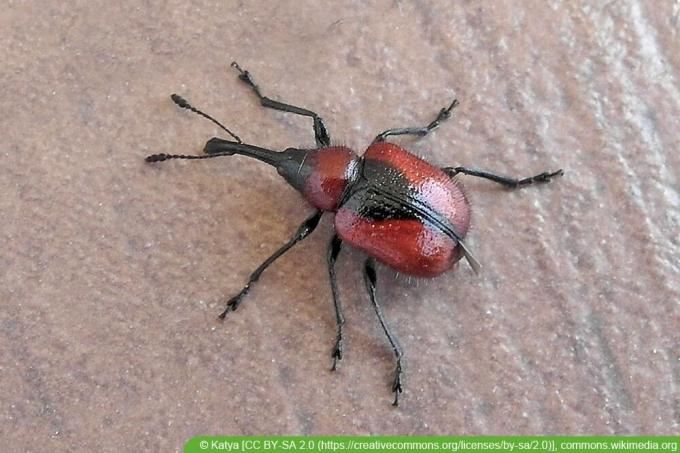
Synonyms: Bud picker, raspberry blossom picker
Damage:
- cut stem below half of the bud
- Females lay an egg in each bud
- Larvae feed on the inside of the bud
- new generation in June and July: still feeding on the leaves
Measures:
- drooping or Burn fallen buds or safely dispose of them in the household waste
Rose brush wasp (Arge rosae; argue ochropus)
Synonyms: Yellow bow tie, sewing bow tie
Damage:
- Oviposition at the top of the rose shoots
- 15-20 pieces in a row
- seam-like structure (name!)
- tan spots
- twisting shoots
- Larvae eat leaves (from leaf margin to midrib)
Measures:
- Remove larvae mechanically
- Cut off shoot tips with clutches
Rose flea beetle (Luperomorpha xanthodera)
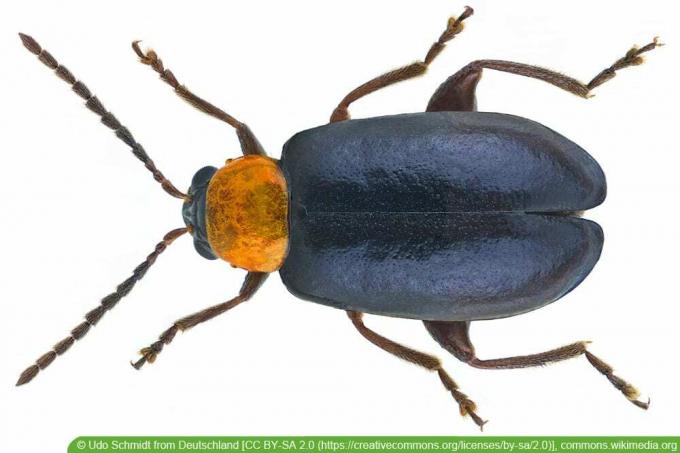
Synonyms: flea beetle
Damage:
- adult beetles: pollen and nectar, feeding on flowers
- Larvae in the root system of the plants (suspected)
Measures:
- usually no control necessary
Arrow owl (Acronica psi; Arconycta psi; Apatele psi)
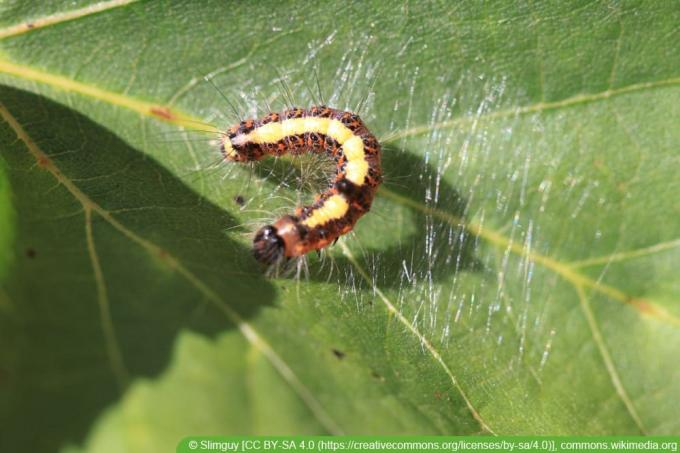
Damage:
- leaf feeding of the caterpillars
Measures:
- mechanical removal of the caterpillars
Black sawfly (Endelomyia aethiops; Caliora aethiops)
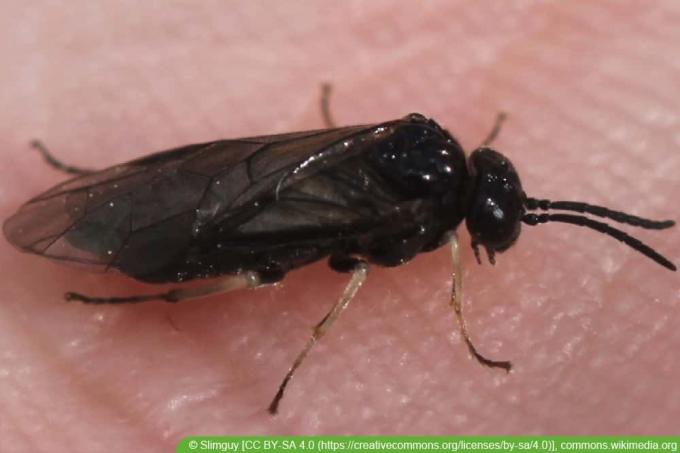
The plant wasp also belongs to the real sawflies, more precisely to the subfamily of the Heterarthrinae.
Synonyms: rose sawfly
Damage:
- Scraping marks on the leaf edges and leaf tops
- "holes" in the rose petals
- Leaves are "skeletonized"
- Infestation recognizable from May or June
- Roses that are particularly endangered: Field rose (Rosa arvensis), Dog rose (Rosa canina)
Measures:
- Remove affected leaves and shoots immediately and dispose of with household waste
leaf miner
Under the so-called Miner damage is to be understood as a form of damage that is inside the shoots. Because in this case the offspring does not eat externally, but "drills" feeding tunnels into the shoots. This so-called Mining tunnels are not so easy to recognize from the outside. But often the entry point is a good indicator of the infestation.
Downward Rose Shoot Borer (Ardis brunniventis)
damage picture:
- short mining tunnels at the shoot tip
- up to 5 centimeters long
- Shoot tip snaps off and dies
Upward-climbing rose shoot borer (Blennocampa elongatula)
- Mining tunnels in the direction of the Triebspitze
- up to 10 centimeters long
- Drill hole often under a spike
- Crumbs of feces at the drilling hole
- Egg-laying from April
Fight:
- Cut off affected shoots down to the healthy wood
Rose leaf miner (Coptotriche angusticollella; Emmetia angusticollella, Tischeria angusticollella)
damage picture:
- Upper side of leaf: light colored space mines
- e.g. T.: whole leaf affected
- inside the mine: light-colored larva
- easily recognizable in the backlight
Fight:
- remove affected leaves
Rose jewel beetle (Agrilus cuprescens)
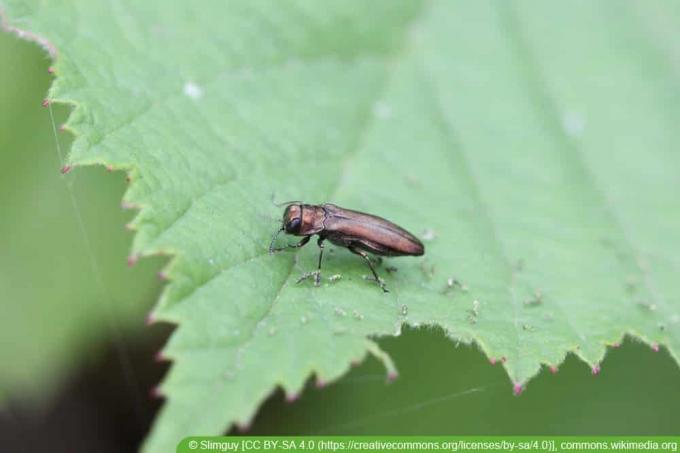
damage picture:
- mining larvae in the shoots of roses
- discoloration of the shoots
- spindle-shaped swelling of the shoots
- cracks on the surface
- shoots break off
- reduced sprouting or complete failure
- dried buds
- Beetle hatches in June, feeding damage (negligible)
Fight:
- Cut back affected shoots
 Home editorial office
Home editorial office
Learn more about roses

What goes with roses: 30 beautiful rose companions
The beauty of roses really comes into its own when surrounded by the right companion plants. It is important for rose companions that they have similar requirements to roses. We tell you what goes well with roses.
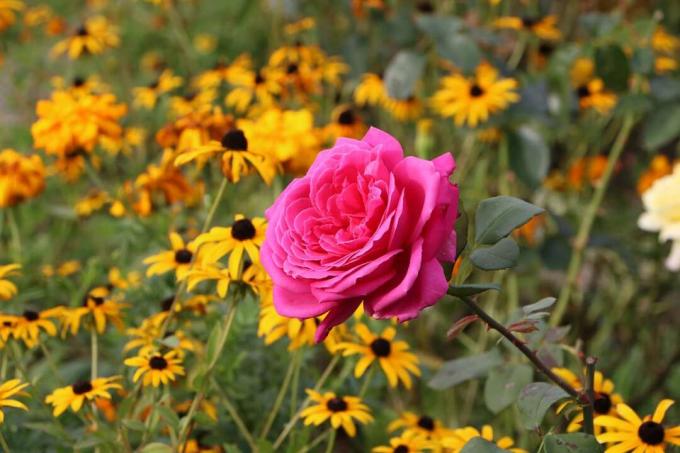
Rose soil: mix soil for roses yourself | composition
The rose is considered the queen of flowers and she is very demanding. When it is newly planted, the soil should therefore be optimally prepared. Special rose soils are particularly suitable for planting. How to make them yourself is in this post.

Rose cuttings: 8 tips for propagating roses
Roses can be propagated quite easily with the help of cuttings if the site conditions and the preparation are right. Both the time and the care play an important role in ensuring that the rose shoot takes root successfully and then thrives magnificently.

Combat rose pests | 10 typical pests on roses
Roses are the pride of many ornamental gardens. But in addition to diseases, pests also give you trouble again and again. Anyone who knows how to recognize and fight them can easily and quickly protect their darlings from most dangers.

Rose care in spring | 5 tips for the new season
The rose, the queen of flowers, should not be missing in any garden! If you want to enjoy the blooming splendor of bedding, hedge and climbing roses in summer, you have to start caring for the roses in spring. We have put together the most important information for you.
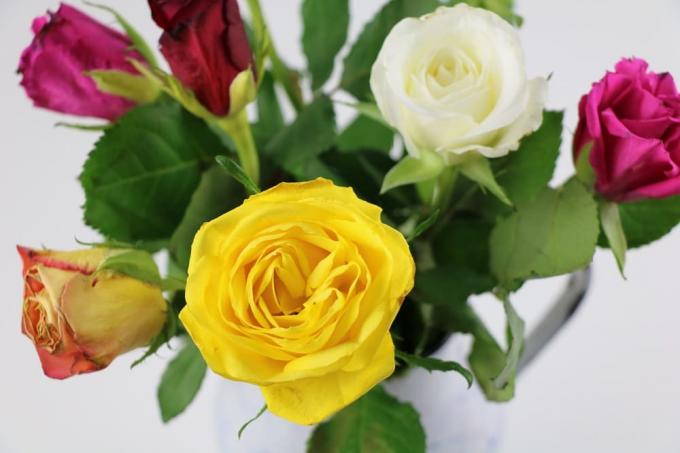
Refining roses | When is the best time of year?
The interested layman can and may also propagate beautifully blooming hybrid tea roses for their own use by grafting. This is - if you know how it works - not difficult and easy to learn even for non-experts. Here we explain what you need to look out for.



